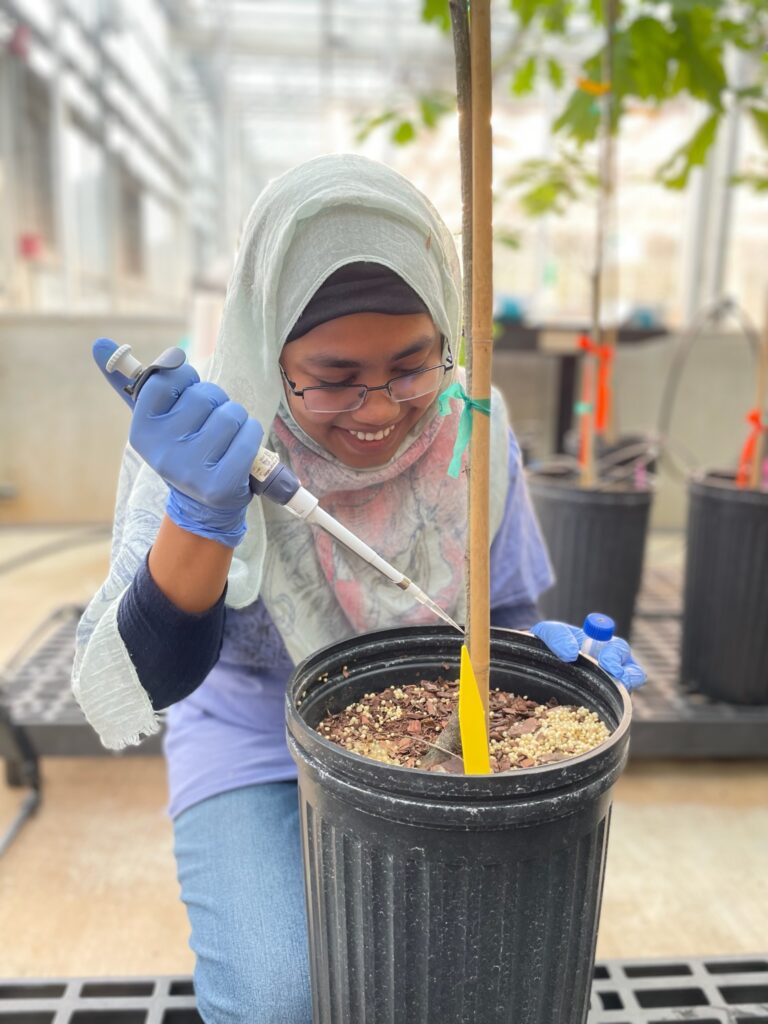
Meher Ony, a doctoral student from Bangladesh, is dedicated to advancing our understanding of forest resources. Ony pursued a bachelor’s degree in biological sciences before joining the University of Tennessee in 2017 to earn a master’s degree in plant pathology. Now, under the guidance of associate professors Denita Hadziabdic Guerry and Margaret Staton, Ony’s research focuses on developing rapid molecular detection tools and investigating gene clusters that contribute to disease resistance in oaks.
Q&A with Meher Ony
Can you tell me a little bit about yourself?
I am Meher Ony from Bangladesh, a country in South Asia. I was born and raised in Chattagram, where I also attended college, all while dreaming of studying abroad. I earned my bachelor of science degree in biological sciences with a concentration in zoology. In 2017, I joined the University of Tennessee to pursue an MS in plant pathology. Currently, I am pursuing my PhD under the supervision of Dr. Denita Hadziabdic and Dr. Margaret Staton, conducting exciting research to support forest resources.
What is your concentration?
My PhD concentration is bioinformatics, genomics and molecular interactions.
What academic classes have been your favorite and why?
EPP 622: Bioinformatics Applications and STAT 578: Data mining. I learned a lot from both classes while having fun with large datasets. These classes made me comfortable with statistical modeling, programming and bioinformatics tools. They helped me tremendously with my current research in population genetics and genomics.
What is your current research question?
My current research focuses on following major objectives:
- Developing rapid molecular detection tools for vascular disease laurel wilt and oak wilt. My goal is to develop fast, sensitive and cost-effective TaqMan probe based detection tools that will enable us to detect the pathogen presence within 24hours of samples collection, even from asymptomatic trees.
- Using dual-RNAseq experiment, looking into host and pathogen transcriptomics to identify and characterize gene clusters that contribute to white oak resistance to oak wilt disease and genes contributes pathogen invasion in the oak host system.
Can you tell me more about your research?
Oak wilt is caused by the fungal pathogen Bretziella fagacearum. North American oaks differ in their susceptibility to oak wilt disease. Infected red oak species group may die 4-6 weeks following infection whereas white oak species have shown moderate to high resistance. Our understanding of the underlying host-resistance mechanisms involved in the differential defense responses to oak wilt disease among different oak species is severely limited. This knowledge gap hinders our ability to identify disease resistant oak genotypes for future breeding programs. Our objective is to use a dual-RNAseq experiment to identify and characterize gene clusters that contribute to white oak resistance to oak wilt disease. We also sought to characterize genes involved in the pathogenicity and virulence of Bretziella fagacearum. The outcome of this study will inform future disease management strategies and develop biomarker(s) valuable for selecting oak wilt resistant genotypes for selective breeding programs.
What are the primary obstacles in answering this question?
I came across quite a few obstacles since I started the PhD projects. However, the most significant one was extracting RNA from mature oak xylem tissue. RNA extraction is a very temperature-sensitive process and degrades quickly. Unfortunately, oak xylem is hardy tissue to grind and extract quality RNA. I struggled to achieve satisfactory quality and quantity of the samples. I tried many protocols and modifications to finalize an effective extraction protocol, which took me about a year.
How has your academic training at The University of Tennessee prepared you for a career?
Since starting grad school, my critical thinking, scientific communication, collaboration, and mentoring skills have developed tenfold. These enhanced abilities will greatly benefit me in my future career.
What do you believe is your biggest academic achievement?
I believe my biggest achievement has been discovering my strengths and weaknesses. Throughout various research and personal challenges, I have learned patience and perseverance. By focusing on the right motivations and surrounding myself with the best people, I have grown significantly. I have also learned to compete not with others but with myself, striving for continuous improvement each day. This journey has made me proud of who I am.
What has been the highlight of your graduate school experience so far?
I will always remember the day when my first first-authored paper was published.
What are your favorite things to do on campus?
I like to stroll through UT Gardens regularly and appreciate all the effort the garden staff invests in maintaining every beautiful corner. I also enjoy spending time in the quiet corners of Pendergrass Library.
What extracurricular activities do you participate in?
I have been part of EPP social committee for three years. I was also part of the Plant Research Center (PRC) colloquium speaker search and arrangement committee for one year, which was a great experience.
What are your favorite hobbies?
I like to read and craft. I also enjoy taking my three-year-old son to parks and baking for him.
Any advice you would like to share with a prospective student?
I would advise them to be kind to themselves. Never fear to try new things and remember to ask for help. You are here to learn and grad school will push you to your limit. Just remember, you are already here which means you have the potential and capabilities to succeed.
Is there anything that you would like to add?
I am lucky to have been part of EPP for the last six years. I am also very grateful to both of my amazing advisors who believe in me.



